Bases
advertisement
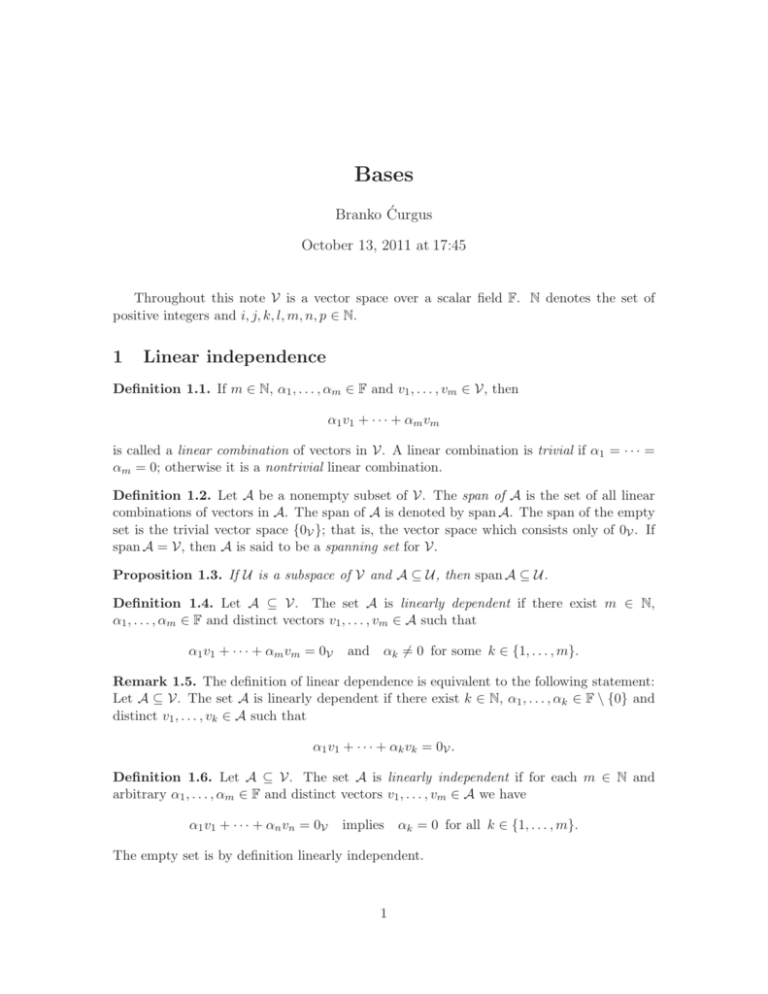
Bases
Branko Ćurgus
October 13, 2011 at 17:45
Throughout this note V is a vector space over a scalar field F. N denotes the set of
positive integers and i, j, k, l, m, n, p ∈ N.
1
Linear independence
Definition 1.1. If m ∈ N, α1 , . . . , αm ∈ F and v1 , . . . , vm ∈ V, then
α1 v1 + · · · + αm vm
is called a linear combination of vectors in V. A linear combination is trivial if α1 = · · · =
αm = 0; otherwise it is a nontrivial linear combination.
Definition 1.2. Let A be a nonempty subset of V. The span of A is the set of all linear
combinations of vectors in A. The span of A is denoted by span A. The span of the empty
set is the trivial vector space {0V }; that is, the vector space which consists only of 0V . If
span A = V, then A is said to be a spanning set for V.
Proposition 1.3. If U is a subspace of V and A ⊆ U , then span A ⊆ U .
Definition 1.4. Let A ⊆ V. The set A is linearly dependent if there exist m ∈ N,
α1 , . . . , αm ∈ F and distinct vectors v1 , . . . , vm ∈ A such that
α1 v1 + · · · + αm vm = 0V
and
αk 6= 0 for some k ∈ {1, . . . , m}.
Remark 1.5. The definition of linear dependence is equivalent to the following statement:
Let A ⊆ V. The set A is linearly dependent if there exist k ∈ N, α1 , . . . , αk ∈ F \ {0} and
distinct v1 , . . . , vk ∈ A such that
α1 v1 + · · · + αk vk = 0V .
Definition 1.6. Let A ⊆ V. The set A is linearly independent if for each m ∈ N and
arbitrary α1 , . . . , αm ∈ F and distinct vectors v1 , . . . , vm ∈ A we have
α1 v1 + · · · + αn vn = 0V
implies
αk = 0 for all k ∈ {1, . . . , m}.
The empty set is by definition linearly independent.
1
It is an interesting exercise in mathematical logic to show that the last two definitions
are formal negations of each other. Notice also that the last two definitions can briefly
be stated as follows: A set A ⊆ V is linearly dependent if there exists a nontrivial linear
combination of vectors in A whose value is 0V . A set A ⊆ V is linearly independent if the
only linear combination whose value is 0V is the trivial linear combination.
The following proposition is an immediate consequence of the definitions.
Proposition 1.7. Let A ⊆ B ⊆ V. If A is linearly dependent, then B is linearly dependent.
Equivalently, if B is linearly independent, then A is linearly independent.
Proposition 1.8. Let A be a linearly independent subset of V. Let u ∈ V be such that
u∈
/ A. Then A ∪ {u} is linearly dependent if and only if u ∈ span A. Equivalently, A ∪ {u}
is linearly independent if and only if u ∈
/ span A.
Proof. Assume that u ∈ spanP
A. Then there exist m ∈ N, α1 , . . . , αm ∈ F and distinct
v1 , . . . , vm ∈ A such that u = m
j=1 αj vj . Then
1 · u − α1 v1 − · · · − αm vm = 0.
Since 1 6= 0 and u, v1 , . . . , vm ∈ A ∪ {u} this proves that A ∪ {u} is linearly dependent.
Now assume that A∪{u} is linearly dependent. Then there exist m ∈ N, α1 , . . . , αm ∈ F
and distinct vectors v1 , . . . , vm ∈ A ∪ {u} such that
α1 v1 + · · · + αm vm = 0V
and
αk 6= 0 for some k ∈ {1, . . . , m}.
Since A is linearly independent it is not possible that v1 , . . . , vm ∈ A. Thus, u ∈ v1 , . . . , vm .
Hence u = vj for some j ∈ {1, . . . , m}. Again, since A is linearly independent αj = 0 is not
possible. Thus αj 6= 0 and consequently
m
1 X
u = vj = −
αi vi .
αj
i=1
i6=j
Proposition 1.9. Let B be a nonempty subset of V. Then B is linearly independent if and
only if u 6∈ span B \ {u} for all u ∈ B. Equivalently,
B is linearly dependent if and only if
there exists u ∈ B such that u ∈ span B \ {u} .
Proof. Assume that B is linearly independent. Let u ∈ B be arbitrary. Then B \ {u} is
linearly independent by Proposition 1.7. Now, with A = B \ {u},
since B = A ∪ {u} is
linearly independent, Proposition 1.8 yields that u 6∈ span B \ {u} .
We prove the converse by proving its contrapositive. Assume that B is linearly dependent. Then there exist m ∈ N, α1 , . . . , αm ∈ F and distinct vectors v1 , . . . , vm ∈ B such
that
m
X
αj vj = 0V and αk 6= 0 for some k ∈ {1, . . . , m}.
j=1
Consequently,
vk = −
m
1 X
αj vj ,
αk
j=1
j6=k
and thus vk ∈ span B \ {vk } .
2
2
Finite dimensional vector spaces. Bases
Definition 2.1. A vector space V over F is finite dimensional if there exists a finite subset
A of V such that V = span A. A vector space which is not finite dimensional is said to be
infinite dimensional.
Since the empty set is finite and since span ∅ = 0V , the trivial vector space 0V is
finite dimensional.
Definition 2.2. A linearly independent spanning set is called a basis of V.
The next theorem shows that each finite dimensional vector space has a basis.
Theorem 2.3. Let V be a finite dimensional vector space over F. Then V has a basis.
Proof. If V is a trivial vector space its basis is the empty set. Let V 6= {0} be a finite
dimensional vector space. Let A be a finite subset of V such that V = span A. Let p = |A|.
Set
K = |C| : C ⊆ A and C is linearly independent .
We first prove that 1 ∈ K. Since V 6= {0} there exists v ∈ A such that v 6= 0V . Set
C = {v}. Then clearly C ⊆ A and C is linearly independent. Thus |C| = 1 ∈ K.
If C ⊆ A, then |C| ≤ |A| = p. Thus K ⊆ {0, 1, . . . , p}. As a subset of a finite set the set
K is finite. Thus K has a maximum. Set n = max K. Since n ∈ K there exists B ⊆ A such
that B is linearly independent and n = |B|.
Next we will prove that span B = V. In fact we will prove that A ⊆ span B. If B = A,
then this is trivial. So Assume that B $ A and let u ∈ A \ B be arbitrary. Then
B ∪ {u} = n + 1 and B ∪ {u} ⊆ A.
Since n = max K, n + 1 6∈ K. Therefore B ∪ {u} is linearly dependent. By Proposition 1.8
u ∈ span B. Hence A ⊆ span B. By Proposition 1.3, V = span A ⊆ span B. Since span B ⊆
V is obvious, we proved that span B = V. This proves that B is a basis of V.
The second proof of Theorem 2.3. We will reformulate Theorem 2.3 so that we can use the
Mathematical induction. Let n be a nonnegative integer. Denote by P (n) the following
statement: If V = span A and |A| = n, then there exists linearly independent set B ⊆ A
such that V = span B.
First we prove that P (0) is true. Assume that V = span A and |A| = 0. Then A = ∅.
Since ∅ is linearly independent we can take B = A = ∅.
Now let k be an arbitrary nonnegative integer and assume that P (k) is true. That is we
assume that the following implication is true: If U = span C and |C| = k, then there exists
linearly independent set D ⊆ C such that U = span D. This is the inductive hypothesis.
Next we will prove that P (k + 1) is true. Assume that V = span A and |A| = k + 1.
Let u ∈ A be arbitrary. Set C = A \ {u}. Then |C| = k. Set U = span C. The inductive
hypothesis P (k) applies to the vector space U . Thus we conclude that there exists a linearly
independent set D ⊆ C such that U = span D.
We distinguish two cases: Case 1. u ∈ U = span C and Case 2. u 6∈ U = span C.
In Case 1 we have A ⊆ span C. Therefore, by Proposition 1.3, V = span A ⊆ U ⊆ V.
3
Thus V = U and we can take B = D in this case. In Case 2, u 6∈ U = span D. Since
D is linearly independent Proposition 1.8 yields that D ∪ {u} is linearly independent. Set
B = D ∪ {u}. Since U = span C = span D ⊆ span B we have that C ⊆ span B. Clearly
u ∈ span B. Consequently, A ⊆ span B. By Proposition 1.3 V = span A ⊆ span B ⊆ V.
Thus V = span B. As proved earlier B is linearly independent and B ⊆ A. This proves
P (k + 1) and completes the proof.
3
Dimension
Theorem 3.1 (The Steinitz exchange lemma). Let A ⊆ V be a spanning set for V such
that |A| = p. Let B ⊆ V be a finite linearly independent set such that |B| = m. Then m ≤ p
and there exists C ⊆ A such that |C| = p − m and B ∪ C is a spanning set for V.
Proof. Let A ⊆ V be a spanning set for V such that |A| = p.
The proof is by mathematical induction on m. Since the empty set is linearly independent the statement makes sense for m = 0. The statement is trivially true in this case.
(You should do a proof of the case m = 1 as an exercise.)
Now let k be a nonnegative integer and assume that the following statement (the inductive hypothesis) is true: If D ⊆ V is a linearly independent set such that |D| = k, then
k ≤ p and there exists E ⊆ A such that |E| = p − k and D ∪ E is a spanning set for V.
To prove the inductive step we will prove the following statement: If B ⊆ V is a linearly
independent set such that |B| = k + 1, then k + 1 ≤ p and there exists C ⊆ A such that
|C| = p − k − 1 and B ∪ C is a spanning set for V.
Assume that B ⊆ V is a linearly independent set such that |B| = k + 1. Let u ∈ B be
arbitrary. Set D = B \{u}. Since B = D ∪{u} is linearly independent, by Proposition 1.9 we
have u 6∈ span D. Also, D is linearly independent and |D| = k. The inductive assumption
implies that k ≤ p and there exists E ⊆ A such that |E| = p − k and D ∪ E is a spanning
set for V. Since D ∪ E is a spanning set for V and u ∈ V, u can be written as a linear
combination of vectors in D ∪ E. But, as we noticed earlier, u 6∈ span D. Thus, E =
6 ∅.
Hence, p − k = |E| ≥ 1. Consequently, k + 1 ≤ p is proved. Since u ∈ span D ∪ E , there
exist i, j ∈ N and u1 , . . . , ui ∈ D and v1 , . . . , vj ∈ E and α1 , . . . , αi , β1 , . . . , βj ∈ F such that
u = α1 u1 + · · · + αi ui + β1 v1 + · · · + βj vj .
Since u 6∈ span D at least one of β1 , . . . , βj ∈ F is nonzero. But, by dropping v-s with zero
coefficients we can assume that all β1 , . . . , βj ∈ F are nonzero. Then
v1 =
1
u − α1 u1 − · · · − αi ui − β2 v2 − · · · − βj vj .
β1
Now set C = E \ {v1 }. Then |C| = p − k − 1. Notice that u, u1 , . . . , ui ∈ B and v2 , . . . , vj ∈ C;
so the last displayed equality implies
that v1 ∈ span B ∪ C . Since E = C ∪ {v1 } and D ⊆ B,
it follows that D ∪ E ⊆ span B ∪ C . Therefore,
V = span D ∪ E ⊆ span B ∪ C .
Hence, span B ∪ C = V and the proof is complete.
4
The following corollary is a direct logical consequence of the Steinitz exchange lemma.
It is in fact a partial contrapositive of the lemma.
Corollary 3.2. Let B be a finite subset of V. If V is a finite dimensional space over F,
then there exists p ∈ N such that |B| > p implies B is linearly dependent.
Proof. Assume that B be a finite subset of V and V is a finite dimensional space over F.
Then there exists a finite subset A of V such that V = span A. Set p = |A|. Then the
Steinitz exchange lemma yields the following implication: If B is linearly independent, then
|B| ≤ p. The contrapositive of the last implication is the claim of the corollary.
Corollary 3.3. Let V be a finite dimensional space over F. If C is an infinite subset of V,
then C is linearly dependent.
Proof. Let p ∈ N be a number whose existence has been proved in Corollary 3.2. Let C be
an infinite subset of V. Since C is infinite it has a finite subset A such that |A| = p + 1.
Corollary 3.2 yields that A is linearly dependent. Since A ⊆ C, by Proposition 1.7, C is
linearly dependent.
Theorem 3.4. Let V be a finite dimensional vector space and let B and C be bases of V.
Then |B| = |C|.
Proof. Let B and C be bases of V. Since both B and C are linearly independent Corollary 3.3
implies that they are finite. Now we can apply the Steinitz exchange lemma to the finite
spanning set B and the finite linearly independent set C. We conclude that |C| ≤ |B|.
Applying again the Steinitz exchange lemma to the finite spanning set C and the finite
linearly independent set B we conclude that |B| ≤ |C|. Thus |B| = |C|.
Definition 3.5. The dimension of a finite dimensional vector space is the number of vectors
in its basis.
Proposition 3.6. Let V be a finite dimensional vector space over F and let B he a finite
subset of V. Then any two of the following three statements imply the remaining one.
(a) |B| = dim V.
(b) span B = V.
(c) B is linearly independent.
Proof. The easiest implication is: (b) and (c) imply (a). This is the definition of the
dimension.
It is easier to prove the partial contrapositive of the implication (a) and (b) imply (c).
First observe that Theorem 3.1 yields that (b) implies |B| ≥ dim V. Therefore a partial
contrapositive of (a) and (b) imply (c) is the following implication:
⇒
(b) and not (c)
|B| > dim V.
Here is a simple proof. Assume that span B = V and B is linearly dependent. Then B
is nonempty and by Proposition 1.9 there exists u ∈ B such that u ∈ span B \ {u} .
5
Consequently, B ⊆ span B \ {u} and by Proposition 1.3, V = span B \ {u} . By the
Steinitz exchange lemma |B \ {u}| ≥ dim V. Therefore |B| > dim V.
Now assume (a) and (c). Let A be a basis of V. By the Steinitz
exchange lemma there
exists C ⊆ A such that |C| = |A| − |B| = 0 such that span B ∪ C = V. Since C = ∅, (b)
follows.
In the following proposition we characterize infinite dimensional vector spaces.
Proposition 3.7. Let V be a vector space over F. Set A0 = ∅. The following statements
are equivalent.
(a) The vector space V over F is infinite dimensional.
(b) For every n ∈ N there exists linearly independent set An ⊆ V such that |An | = n and
An−1 ⊂ An .
(c) There exists an infinite linearly independent subset of V.
Proof. We first prove (a)⇒(b). Assume (a). For n ∈ N, denote by P (n) the following
statement:
There exists linearly independent set An ⊆ V such that |An | = n and An−1 ⊂ An .
We will prove that P (n) holds for every n ∈ N. Mathematical induction is a natural tool
here. Since the space {0V } is finite dimensional, we have V 6= {0V }. Therefore there exists
v ∈ V such that v 6= 0V . Set A1 = {v} and the proof of P (1) is complete. Let k ∈ N and
assume that P (k) holds. That is assume that there exists linearly independent set Ak ⊆ V
such that |Ak | = k. Since V is an infinite dimensional, span Ak is a proper subset of V.
Therefore there exists u ∈ V such that u 6∈ span Ak . Since Ak is also linearly independent,
Proposition 1.8 implies that Ak ∪ {u} is linearly independent. Set Ak+1 = Ak ∪ {u}. Then,
since |Ak+1 | = k + 1 and Ak ⊂ Ak+1 , the statement P(k + 1) is proved.
This proves (b).
Now we prove (b)⇒(c). Assume (b) and set C = ∪ An : n ∈ N . Then C is infinite. To
prove that C is linearly independent, let m ∈ N be arbitrary and let v1 , . . . , vm be distinct
vectors in C and let α1 , . . . , αm ∈ F such that
α1 v1 + · · · + αm vm = 0V .
By the definition
of C, for every k ∈ {1, . . . , m} there exists nk ∈ N such that vk ∈ Ank .
Set q = max nk : k ∈ {1, . . . , m} . By the inclusion property of the sequence An , we have
Ank ⊆ Aq for all k ∈ {1, . . . , m}. Therefore, vk ∈ Aq for all k ∈ {1, . . . , m}. Since the set
Aq is linearly independent we conclude that αk = 0F for all k ∈ {1, . . . , m}. This proves
(c).
The implication (c)⇒(a) is a partial contrapositive of Corollary 3.3. This completes the
proof.
6
4
Subspaces
Proposition 4.1. Let U be a subspace of V. If U is infinite dimensional, then V is infinite
dimensional. Equivalently, if V is finite dimensional, then U is finite dimensional. (In plain
English, every subspace of a finite dimensional space is finite dimensional.)
Proof. Assume that U is infinite dimensional. Then, by the sufficient part of Proposition 3.7,
for every n ∈ N there exists A ⊆ U such that |A| = n and A is linearly independent. Since
U ⊆ V, we have that for every n ∈ N there exists A ⊆ V such that |A| = n and A is linearly
independent. Now by the necessary part of Proposition 3.7 we conclude that V is infinite
dimensional.
Theorem 4.2. Let V be a finite dimensional vector space and let U be a subspace of V.
Then there exists a subspace W of V such that V = U ⊕ W.
Proof. Let B be a basis of V and let A a basis of U . By Proposition 4.1, the Steinitz
exchange lemma applies to the finite spanning set B and the finite linearly independent
set
A. Consequently, there exists C ⊆ B such that |C| = |B|−|A| and such that span A∪C = V.
Applying the Steinitz exchange lemma again to the linearly independent set B and the
spanning set A ∪ C we conclude that |A ∪ C| ≥ |B|. Since clearly |A ∪ C| ≤ |A| + |C| = |B|
we have |A ∪ C| = |A| + |C| = |B| = dim V. Now the statement (a) and (b) imply (c) from
Proposition 3.6 yields that A ∪ C is a basis of V. Set W = span C. Then, since A ∪ C is a
basis of V, V = U + W. It is not difficult to show that U ∩ W = {0V }. Thus V = U ⊕ W.
This proves the theorem.
Lemma 4.3. Let V be a finite dimensional vector space and let U and W be subspaces of
V such that V = U ⊕ W. Then dim V = dim U + dim W.
Proof. Let A and B be basis of U and W respectively. Using V = U + W, it can be
proved that A ∪ B spans V. Using U ∩ W = {0V }, it can be shown that A ∪ B is linearly
independent and A ∩ B = ∅. Therefore A ∪ B is a basis of V and consequently dim V =
|A ∪ B| = |A| + |B| = dim U + dim V.
Theorem 4.4. Let V be a finite dimensional vector space and let U and W be subspaces of
V such that V = U + W. Then
dim V = dim U + dim W − dim U ∩ W .
Proof. Since U ∩ W is a subspace of U Theorem 4.2 implies that there
exists a subspace U1
of U such that U = U1 ⊕ (U ∩ W) and dim U = dim U1 + dim U ∩ W . Similarly, there exists
a subspace W1 of W such that W = W1 ⊕ (U ∩ W) and dim W = dim W1 + dim U ∩ W .
Next we will prove that V = U ⊕ W1 . Let v ∈ V be arbitrary. Since V = U + W there exist
u ∈ U and w ∈ W such that v = u + w. Since W = W1 ⊕ (U ∩ W) there exist w1 ∈ W1 and
x ∈ U ∩ W such that w = w1 + x. Then v = u + w1 + x = (u + x) + w1 . Since u + x ∈ U
this proves that V = U + W1 . Clearly U ∩ W1 ⊆ U ∩ W and U ∩ W1 ⊆ W1 . Thus,
U ∩ W1 ⊆ U ∩ W ∩ W1 = {0V }.
Hence, U ∩W1 = {0V }. This proves
V = U ⊕W1 . By Lemma 4.3, dim V = dim U +dim W1 =
dim U + dim W − dim U ∩ V . This completes the proof.
7
Combining the previous theorem and Lemma 4.3 we get the following corollary.
Corollary 4.5. Let V be a finite dimensional vector space and let U and W be subspaces of
V such that V = U +W. Then the sum U +W is direct if and only if dim V = dim U +dim W.
The previous corollary holds for any number of subspaces of V. The proof is by mathematical induction on the number of subspaces.
Proposition 4.6. Let V be a finite dimensional vector space and let U1 , . . . , Um be subspaces
of V such that V = U1 + · · · + Um . Then the sum U1 + · · · + Um is direct if and only if
dim V = dim U1 + · · · + dim Um .
8
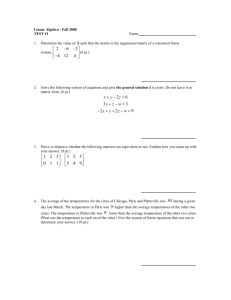
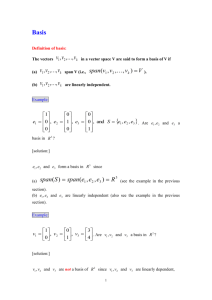
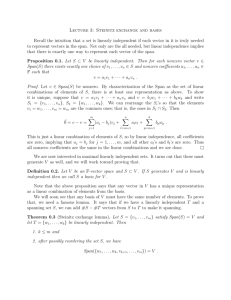

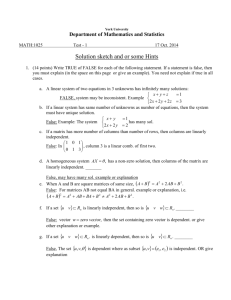

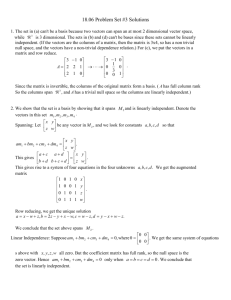
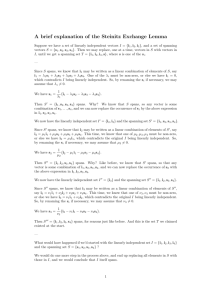
![2010Fall-LA-Lecture-13[1]](http://s3.studylib.net/store/data/006762182_1-3901e79b726aad1cc0b426785aced7c7-300x300.png)
